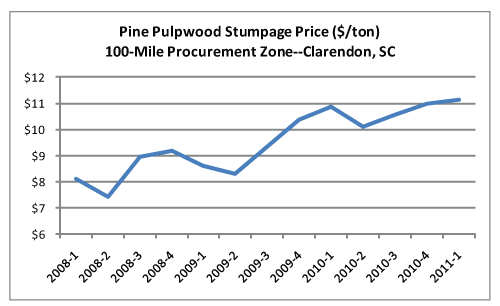
New facility announcements have become rare occurrences since the recession began. It bears mentioning, therefore, that Georgia-Pacific has begun the final construction phase at its Clarendon facility. The plant, one of two OSB mills that Georgia-Pacific purchased from Grant Forest Products last year, is expected to have the same capacity as its Allendale facility: 850 MMsf/year, 3/8 basis. Construction of the plant is expected to take most of 2011, with operations expected to start in December. If the plant were to operate at capacity, which is unlikely until the housing market turns around, it will consume 1.7 million tons of pine pulpwood.
What will this additional demand mean for pine pulpwood supply and price in the 100-mile procurement zone around the Clarendon facility?
In the last three years, pine pulpwood stumpage prices have appreciated 37 percent in this procurement zone. In 2010, 10.5 million tons of pine roundwood was consumed by pulp/paper, OSB, and chipmills in the area. If the Clarendon mill takes 1 million tons of pine pulpwood (similar to what the Allendale facility currently consumes), demand in the wood basin will increase by 10 percent.

We expect the trend set in the last three years will continue. Once the economy improves, however, the Clarendon wood basin could experience significant disruption.
Why? The growth-to-removal ratio (GRR) in the area—which is calculated by dividing the annual volume of forest growth by the volume of material harvested in that forest during the same year--shows that increased demand will put pressure on pine pulpwood supply. The growth-to-drain ratio for this material in the 100-mile procurement zone is currently 1.21 (a GRR of 1.0 is considered healthy and sustainable; a GRR of significantly more than 1.0 means a forest is underutilized, and a GRR of less than 1 indicates that harvest levels are unsustainable).While current harvest levels are sustainable, our GRR forecast model shows that an additional 1 million tons of consumption will drive the GRR for pine pulpwood below 1.0 and remain there for a decade.
In the short term, this pressure will be mitigated to some degree by the fact that demand for small sawlogs, also called chip-n-saw (logs that measure 9-11” in diameter at breast height) is weak. As long as the housing market continues to struggle, chip-n-saw sized material will be merchandized as pulpwood, adding to the available supply.
Because current demand in the Clarendon procurement zone will soon eclipse forest growth in the area, the upward trend in pine pulpwood prices is likely to be steeper. All consumers of wood fiber—pulp/paper mills, OSB mills, and energy companies—will see the costs of their raw materials climbing. Other OSB mills, because they are farther away, may not see significant price increases. They will be affected by the increased competition in the end product market, however.


 Suz-Anne Kinney
Suz-Anne Kinney


